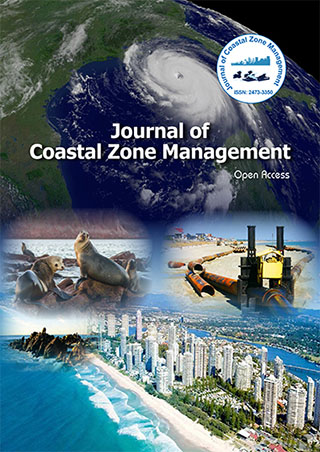Indexed In
- SafetyLit
- RefSeek
- Hamdard University
- EBSCO A-Z
- OCLC- WorldCat
- Publons
Useful Links
Share This Page
Journal Flyer

Open Access Journals
- Agri and Aquaculture
- Biochemistry
- Bioinformatics & Systems Biology
- Business & Management
- Chemistry
- Clinical Sciences
- Engineering
- Food & Nutrition
- General Science
- Genetics & Molecular Biology
- Immunology & Microbiology
- Medical Sciences
- Neuroscience & Psychology
- Nursing & Health Care
- Pharmaceutical Sciences
Commentary - (2023) Volume 26, Issue 6
Coastal Aquifers: Examining the Consequences of Escalating Sea Intensity and Environmental Changes
Ping Xem*Received: 01-Nov-2023, Manuscript No. JCZM-23-23794; Editor assigned: 03-Nov-2023, Pre QC No. JCZM-23-23794 (PQ); Reviewed: 24-Nov-2023, QC No. JCZM-23-23794; Revised: 01-Dec-2023, Manuscript No. JCZM-23-23794 (R); Published: 08-Dec-2023, DOI: 10.35248/2473-3350.23.26.597
Description
Climate change and sea level rise are two interconnected phenomena that pose significant threats to coastal aquifers, significant sources of freshwater for many communities around the world. As the Earth's climate undergoes rapid changes due to human activities such as burning fossil fuels and deforestation, the impacts on coastal aquifers become increasingly pronounced, with far-reaching consequences for both the environment and human populations.
One of the most direct effects of climate change on coastal aquifers is the alteration of precipitation patterns. Changes in temperature and atmospheric conditions lead to shifts in rainfall, causing some regions to experience more intense and frequent storms, while others suffer from prolonged droughts. These variations in precipitation can result in changes to groundwater recharge rates, affecting the overall availability of freshwater in coastal aquifers. In regions experiencing increased rainfall, there may be a higher risk of aquifer contamination as pollutants are flushed into the groundwater system.
Sea level rise, another consequence of climate change, compounds the challenges faced by coastal aquifers. As global temperatures rise, glaciers and ice sheets melt, contributing to the swelling of the oceans. The rising sea levels lead to saltwater intrusion into coastal aquifers, where saltwater from the sea infiltrates freshwater resources. This intrusion can render once-potable water undrinkable and threaten the agricultural activities that rely on freshwater irrigation. The delicate balance between saltwater and freshwater is disrupted, with long-lasting impacts on the ecosystems and communities that depend on these aquifers.
The effects of saltwater intrusion are particularly evident in low-lying coastal areas, where aquifers are more vulnerable to the encroaching sea. As saltwater infiltrates the aquifers, it displaces freshwater, creating a wedge of saltwater that extends inland. This phenomenon not only diminishes the quantity of available freshwater but also degrades its quality, making it unsuitable for consumption or agricultural use. Coastal communities that rely on these aquifers for their water supply face the dual challenge of adapting to both reduced freshwater availability and the increased costs associated with treating saline water.
Furthermore, the impacts of climate change on extreme weather events, such as hurricanes and typhoons, exacerbate the vulnerability of coastal aquifers. Intense storms can lead to storm surges and flooding, causing immediate and severe contamination of groundwater sources. The increased frequency and intensity of these events can result in long-term damage to the infrastructure that supports aquifer recharge and extraction systems, further compromising the resilience of coastal water supplies.
In response to these challenges, it is significant for the communities to implement adaptive measures to protect and sustain their coastal aquifers. This may include the development of resilient infrastructure, such as improved storm water management systems and the construction of barriers to mitigate the impacts of storm surges. Additionally, sustainable water use practices and the promotion of water conservation can help alleviate the pressure on aquifers and reduce the risk of saltwater intrusion.
Global cooperation is also essential in addressing the root causes of climate change and mitigating its impacts on coastal aquifers. Efforts to reduce greenhouse gas emissions and transition to renewable energy sources can contribute to slowing the pace of climate change and, consequently, alleviate some of the pressures on coastal ecosystems.
In conclusion, the effects of climate change and sea level rise on coastal aquifers are multifaceted and pose significant challenges to both the environment and human communities. As we witness shifts in precipitation patterns, rising sea levels, and more extreme weather events, it is imperative that we take proactive measures to protect and sustain these vital freshwater sources. Through a combination of adaptive strategies, sustainable practices, and global cooperation, we can work towards ensuring the resilience of coastal aquifers in the face of uncertain climatic aquifers.
Citation: Xem P (2023) Coastal Aquifers: Examining the Consequences of Escalating Sea Intensity and Environmental Changes. J Coast Zone Manag. 26.597.
Copyright: © 2023 Xem P. This is an open-access article distributed under the terms of the Creative Commons Attribution License, which permits unrestricted use, distribution, and reproduction in any medium, provided the original author and source are credited.
